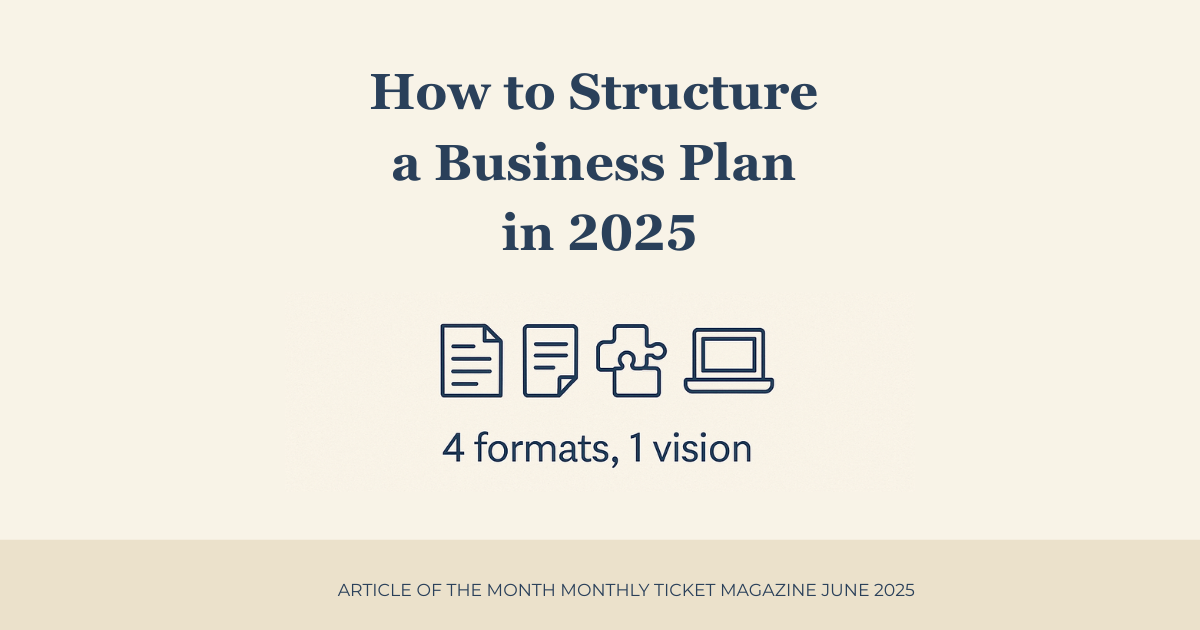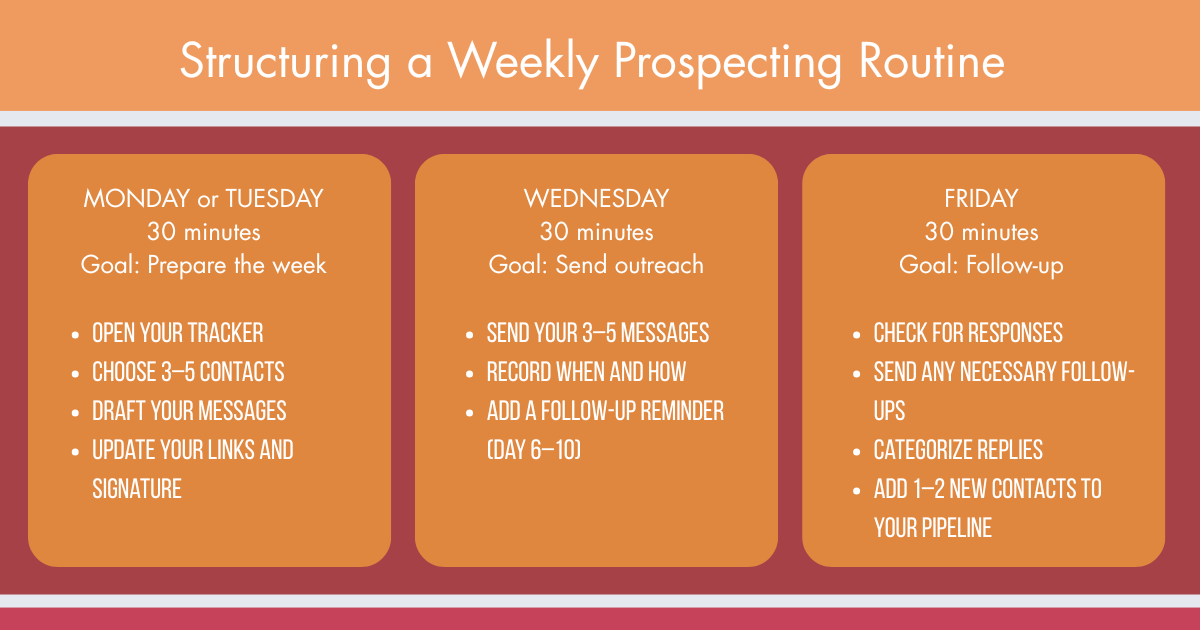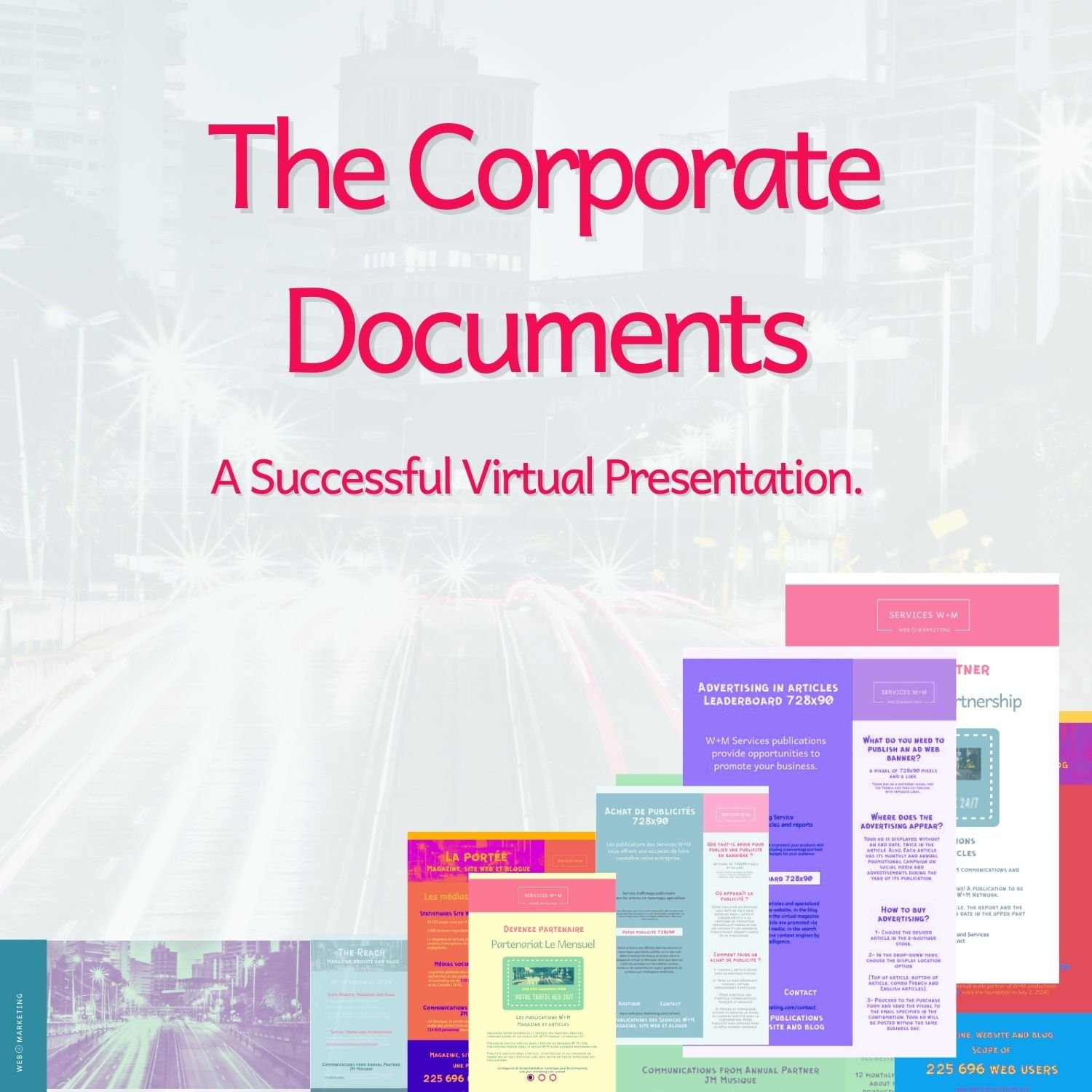The Magazine of Digital Business Tools and Services
Read the news about websites and marketing strategies in Quebec. Free subscription to W+M articles, reports and publications.
Business Plan - Monthly Ticket - June 2025
Prospecting, business models, W+M 2026 Media Kit and digital tools, a structured approach to grow your project. Read the June edition now.
Hello,
Building a business or creative project often begins with plenty of ideas… and very little structure. But sooner or later, it becomes essential to step back, clarify your intentions, and define a direction.
That’s where the business plan comes in.
In 2025, a business plan is no longer a rigid document written only to impress a bank. It’s an evolving, creative tool, adaptable to the reality of small businesses, freelancers, and independent creators.
We hope this edition helps you take the next step with structure, purpose, and clarity.
Summary
Editorial : Building Without a Plan… but With a Vision.
Article News of the Month: How to Structure a Business Plan in 2025.
Report of the Month: Prospecting Without a Budget: Clear, Human, Strategic.
The News Block: Recent posts from the W+M Marketing Blog.
Tag of the Month: Entrepreneur.
Business, Corporate Documents and PDF in 2025.
Complete Guide: How to Launch Your First Paid Ad on Meta Ads.
2025 SEO Advanced: Techniques and Trends.
Column #ItSAMarketingThing 18: Corporate Promotion Budgets.
Special Report : Discover the Media Kit for the W+M 2026 Season!
Conclusion, sources and credits.
MusicScore: The song to listen while reading this edition is Enjoy the Silence by Depeche Mode.
Vote for the 2025 MusicScore in the Subscription page until the last day of the month of publication.
Building Without a Plan… but With a Vision
Let me share a little secret: the official business plan for Services W+M was completed almost a year after the company was launched.
And yet, monthly, I was moving forward.
Like many creative entrepreneurs, I built my project the way one might assemble a work in progress: one publication at a time, one client at a time, one article, one campaign, one idea… And although nothing was defined at the start, there was already a direction, a desire to make digital marketing tools and creative services more accessible to small businesses, artists, and emerging professionals.
Should I have structured it all into a formal document from the beginning? Maybe. But I wasn’t sure I wanted to.
While a business plan is often presented as the first step in launching a business, it’s possible, and sometimes even recommended, especially for solopreneurs still refining their offer, to build it during the first year, once your services are more clearly shaped and a base level of work or income is in place.
Even just to review your operations and ensure your original vision still holds true, putting together a business plan within that first year can be extremely valuable, especially when it comes to finding partners or securing sponsorships.
This June edition to the rescue
Because in 2025, a good business plan is no longer just an Excel sheet or a PDF meant to impress a bank. It’s a strategic, living, and evolving tool, one that serves your vision. It can take the form of a simple canvas, a Notion doc, a website pitch, a media kit… or even a magazine.
In this issue, you’ll find:
Four inspiring business plan models to help structure your project or revisit what already exists
A guide to help you start prospecting and even with no network or budget
An overview of the key business documents to master in 2025
Practical tools to improve your Meta Ads and SEO strategies
And a special feature on the W+M 2026 Media Kit, a different way of presenting your offer
Maybe as you read these pages, you’ll realize you already have a plan. Even if it’s still being written.
Wishing you a productive month ahead.
Jeff
How to Structure a Business Plan in 2025
Explore the 2025 guide to business plans: classic, lightweight, visual and digital formats, with real-world examples and practical tools for launching your project.
In today’s fast-moving digital world, a business plan isn’t just a formality—it’s your compass. This practical guide breaks down the main types of business plans available in 2025, with real-world examples and tools to help Canadian entrepreneurs take action with clarity and purpose.
This feature includes:
A breakdown of the 4 main business plan formats
Case-based explanations adapted to today’s reality
A full case study (freelance graphic designer)
Downloadable tools and resources
A direct link to the White Paper – Preparing Your First Website
A solid business plan is also your first step toward a realistic and effective promotional strategy. To take things further, #ItSAMarketingThing 18 walks you through setting a marketing budget tailored to your project’s reality.
Three quick tips to help you get started:
Choose a business plan format that fits your current stage.
Review and update it regularly—even if you're not seeking funding.
Start integrating basic projections for your advertising expenses.
Keep reading below for Chronicle #18, the perfect follow-up to this month’s feature article.
When is the best time to talk about business plans?
Best periods
January – February: New Year = business resolutions, annual planning, fresh mindset.
March – April: Grant season, entrepreneurship contests, post-winter momentum.
August – September: Post-vacation restart, ideal time to launch fall projects.
Late November – December: Year-end reviews, strategic reflections, time to plan ahead.
Periods to avoid
National holidays (e.g., Canada Day, Saint-Jean-Baptiste)
Collective vacation weeks (late July to early August = low engagement)
Spring break / School holidays / Holiday season (audience scattered)
So as discussed, let’s circle back in August ;)
Prospecting Without a Budget: Clear, Human, Strategic
Learn how to prospect without a budget in 2025: simple methods, structure, and real human connection — no tools, no gimmicks, just impact.
Reach Out With Clarity and Confidence
Getting started with prospecting, even with no budget, is often what separates a project that moves forward… from one that remains on hold.
As part of this month’s focus on business planning, we’re presenting a comprehensive feature on strategic prospecting, designed for entrepreneurs, creators, and small businesses looking to launch their first outreach efforts without falling into the trap of over-automation.
This step-by-step guide covers:
The 5 key elements to start prospecting right away
Three simple, human techniques to initiate meaningful connections
A structured method for managing follow-ups and tracking progress
A weekly routine you can easily replicate
An essential read for anyone looking to break the silence, grow their network, and build client relationships with clarity and consistency.
Structuring a Weekly Prospecting Routine
One hour a week can change the trajectory of your business. Prospecting should never become an insurmountable obstacle. But for it to work, it needs to become a habit. It's important to establish a simple, clear, and consistent framework.
In short, prospecting is not a sprint but a constant process, and every action taken today will become an anchor for a future opportunity.
Meta Guide
SEO Advanced
The chronicle of digital marketing for startups, businesses and entrepreneurs. It’s a marketing story is told every month in the Monthly Ticket Magazine.
Column #ItSAMarketingThing 18: Corporate Promotion Budgets
How to Set an Effective Promotion Budget
Promotion Budgets
When I first began my entrepreneurial research process, I had the chance to come across an ad for a business start-up training program. This training helped me avoid a major mistake in my business launch: not properly budgeting for all promotional aspects, both physical (documents, gadgets, rental advertising) and digital (website, visuals, programming time).
Yes, I was about to invest my entire budget in digital promotion, completely forgetting the physical essentials for networking, prospect meetings, and demonstration materials. An important aspect to consider when planning a launch budget.
Why clearly define your promo budget?
Clearly defining your budget helps avoid overspending, optimize results, and clarify your strategy. Without precise budget management, you risk spreading yourself too thin and achieving uncertain results.
For example, a small business with an annual production value of $20,000 could allocate about 10%, or $2,000 per year, for promotion. This limited budget requires precise choices and careful planning to avoid unnecessary expenses.
Conversely, a company with an annual production value of about $300,000 could invest up to $30,000 annually in marketing actions. With such a budget, it is crucial to clearly structure allocations by channel to optimize the overall campaign impact.
Where does the 10% promotional budget rule come from?
The general rule of allocating about 10% of revenue to a promotional budget mainly stems from established and recommended practices in the fields of marketing and business management.
This recommendation is often used as a practical starting point for small and medium-sized enterprises (SMEs) to ensure sufficient visibility while remaining financially reasonable. It also originates from classic business management advice and is frequently cited in specialized marketing and business management literature, as well as by professional organizations and sector specialists.
However, this percentage can vary depending on the industry, market maturity, specific business objectives, and overall strategy. Some highly competitive industries (such as consumer goods or tech startups) may spend much more, while more mature or less competitive sectors may invest significantly less.
Structuring your budget effectively
Clearly define your objectives (awareness, sales, product launch)
It is essential to specify exactly what you expect from your promotional campaign. This helps direct your expenses precisely and avoid unnecessary spending. A clear objective also promotes a precise evaluation of the results after the campaign.
Identify your target audience
A good understanding of your target audience is crucial for optimizing your budget. By precisely segmenting your audience according to their characteristics and behaviors, you can effectively target your promotional actions. This prevents wasting your budget on people who have no real interest in your product or service.
Select the most appropriate channels (social media, emails, paid advertising, SEO)
Each channel has its specific advantages and meets particular objectives. For example, social media allows you to quickly reach a wide audience, while SEO provides long-term visibility benefits. A judicious selection of channels based on your audience and objectives is crucial for the success of your promotional strategy.
Allocate your budget based on the importance of chosen channels
It is important to balance your budget by considering the potential effectiveness of each channel. This means prioritizing the channels most promising in terms of return on investment, while reserving part of the budget for measured experimentation. This strategy allows the necessary flexibility and responsiveness to adjust your approach based on results.
Budget: Examples of budget types with practical recommendations:
Small budget (less than $500): Prioritize high-impact but low-cost actions such as targeted advertising on social media (Facebook, Instagram), the creation of attractive organic content (blogs, short videos), and targeted email campaigns to re-engage prospects. Limit expenses to essential tools only.
Medium budget ($500 to $2,000): Combine different tactics to maximize your visibility. For example, use a mix of targeted digital advertising on Google Ads or Meta, invest in an efficient SEO tool to boost your organic ranking, and plan for moderate physical presence through local events or printed promotional material (cards, brochures).
Large budget (over $2,000): Greatly diversify your channels and tools. You could consider sophisticated multi-channel campaigns including advanced ad placements, influencer campaigns, in-depth paid and organic SEO strategies, and automated, personalized email campaigns. Use advanced analytics tools to track real-time results and continuously optimize your performance.
Regularly monitor your performance and adjust your budget based on the results obtained. Use analytics tools to maximize your ROI.
Tips: Here are some common mistakes to avoid:
Neglecting to set clear objectives. Before each campaign, write a simple one-sentence goal and post it visibly at your desk. It will serve as a constant reminder.
Misestimating financial capacities. Quickly review your finances each month to adjust your budget to your actual situation. A simple Excel table is often enough.
Ignoring past performance. Always keep a history of your past campaigns (results, budget spent, ROI). Consult it systematically before launching a new campaign.
Failing to monitor results regularly. Schedule a quick weekly check (15–20 minutes) of key statistics (clicks, conversions, costs) to adjust your strategy without waiting for the end of the campaign.
Tools: Excel spreadsheets for financial management. Use advertising platforms (Meta, Google Ads) and their analytics tools (Google Analytics).
Good budget management in promotion ensures optimal results and an improved ROI. Take the necessary time to structure your budget effectively and monitor your results regularly.
Stay tuned: A complete guide to managing your promotional budget with a practical Excel model will be published in our November 2025 Edition!
Read #itSAMarketingThing
Special Report : Discover the Media Kit for the W+M 2026 Season!
Project 12 Reinvents Itself with Fresh Colours and Formats!
W+M Media Kit Mission
Link your advertising to an edition that suits your products and services. Each month topic is anchored in a coherent strategy. Articles and themes are carefully selected and promoted to reach the right readership for each publication.
The ad placement in specialized articles will meet your digital marketing needs. Since we’re not all professional writers, W+M can take care of this for you.
Discover for each issue:
Ad reservation options in articles and magazines
Bilingual fact sheets in the online store
Ready-to-publish content for your digital strategy
Once again, 12 unique months, 12 digital marketing themes and 12 punchy promos and music colours!
The must-read monthly column: #itSAMarketingThing continues to deliver research and advice for SMEs, creators, startups, and anyone launching a digital project.
Review the 2025 media kit article and vote for your favorite edition's musicScore.
Why Advertise in the W+M Monthly?
Targeted Audience: Entrepreneurs, freelancers, artists, and SMBs in Quebec.
Contextual Content: Your ad appears in a piece closely related to your field.
Extended Visibility: Your visuals stay online permanently, boosting long-term SEO.
Human Touch: Work with a creator, editor, and advisor to shape your message.
Turnkey Service: Need copywriting or visuals? Our team can help.
Visit the online store for your direct advertising space reservation.
Ideas are essential. But it’s the structures behind them that allow them to grow, evolve, and make an impact.
With this issue, our goal was to give you practical tools to help formalize your projects without freezing them in place, and to encourage you to take action without losing your creative spark.
From business planning to prospecting, from strategic documents to digital campaigns, every resource in these pages can become a lever for growth if activated with intention and authenticity.
Take advantage of the summer season to realign your priorities. Review your foundation and start designing your next chapter with clarity.
We wish you a bright and inspiring summer, filled with meaningful connections and new momentum.
We’ll see you again in July with a fresh perspective on what’s next.
Thank you, see you in the next 1st of the Month.
Jeff
Cr Images: W+M Services
Monthly Ticket Theme: Under The Clouds by JM Musique
Production and Publishing: W+M Services







































Learn how to structure your presence on X with professional Highlights: choosing the right content, organizing your featured posts, and designing a clear visual identity.